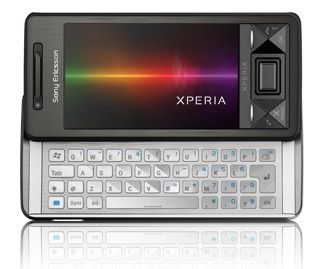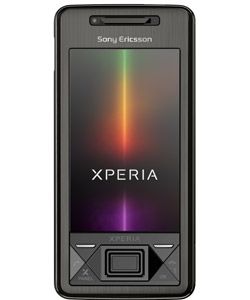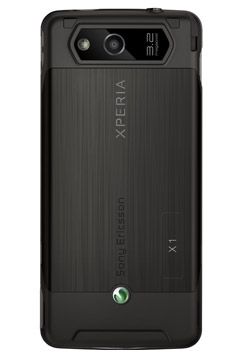Laptop Mag Verdict
This Windows Mobile phone boasts an exquisite physical design and a unique user interface, but it carries too high a price tag.
Pros
- +
Beautiful industrial design
- +
Innovative user interface
- +
Clear call quality
- +
Good camera
Cons
- -
Very expensive
- -
X Panels slow to load
- -
Paltry amount of X Panel add-ins
- -
Lackluster keyboard
Why you can trust Laptop Mag
It has been nearly a year since Sony Ericsson announced its Xperia X1 smart phone. And the time it took to bring this device to market has not dampened our appreciation for its premium arc slider design, refreshing panel interface, and fast data performance (over 3G and Wi-Fi). Despite some drawbacks, we wish this was the phone AT&T and Sprint chose to launch instead of the HTC Touch Pro. However, because the X1 is not backed by a U.S. carrier, this unlocked device is entirely too expensive for the masses. Plus, its overall performance isn't quite snappy.
Design
Touching the Xperia X1 for the first time is somewhat like sitting down in a 7 Series BMW. It looks luxurious and feels expertly crafted. At 4.4 x 2.1 x 0.7 inches, it's longer and a hair wider than the HTC Touch Pro, but just as thick.
The silver brushed-metal exterior is home to a few controls, including call and end buttons, two metal soft menu keys, an X Panel button, OK key, and an optical mouse that doubles as an omnidirectional button; these keys are triangular and a glossy black plastic. A stylus stores in the lower left corner. The large 3-inch, 800 x 480 display is skinny but crisp and colorful, although overly reflective.
The sides of the device are accented by a chrome silver strip, along which you'll find a mini-USB charging port, a power button, a full 3.5mm headphone jack, volume controls, and a camera quick-launch key. Two small lights illuminate to alert you of a phone call, new messages, and more. The rear of the X1 looks industrial. Also made of brushed metal, it has plenty of ridges and angles that add to its beauty. This is also where the 3.2-MP camera and single LED flash reside. The microSD slot is under the battery, so you'll have to open the casing to insert a microSD Card.
Keyboard and Optical Mouse

Click to enlarge
A full QWERTY keyboard slides smoothly from underneath the phone at a slight angle for comfortable typing. The plastic beveled keys look and feel like metal, and the letters are backlit with a white glow under dark conditions. We had no problems entering short Web addresses on the keyboard, but longer text or e-mail messages felt tedious to type; the keys are just barely raised above the surface of the keyboard, so they're lacking tactile feedback when they're pressed. We got used to it over time, but the BlackBerry Curve and Bold offer a better layout.
The optical mouse can take some getting used to. Unlike the Samsung Epix or Omnia, which feature a similar button, it doesn't provide an on-screen cursor. So moving around menus can be difficult without knowing exactly what you're selecting. After we changed the settings to a more comfortable sensitivity, we were able to navigate the phone more easily.

Click to enlargeUser Interface
The X1's claim to fame is its X Panel user interface. You can quickly launch this menu system by pressing the X Panel button on the phone's face. When it's open, you can view 9 different panels that act as shortcut portals into applications such as Google search, FM radio, your calendar, the home screen, your media player, and more. Seven apps come preinstalled. Sony Ericsson released its X Panel software-development kit in September, but only five additional panel downloads are available, including a photo viewer and Dashwire. We hope to see more third-party panels soon.
The X Panel UI can be viewed in two different modes: either as small snapshots in three rows of three, or in a layout that looks like a spread of playing cards. When you flip the phone into landscape mode, its accelerometer rotates the panels to fit. The X1's 528-MHz processor struggled to keep up, though, and the lack of a separate graphics accelerator was noticeable; panels shifted and rotated very slowly.
On most Windows Mobile phones, you can simply hit the End button a few times and be back to the main Today screen. With the Xperia X1, that doesn't happen. Instead, if you close out of something, you're brought back to the last panel you had open in X Panel. To get to the home screen again, you'll need to select Today from the start menu or from that UI overlay, which we found annoying.
The Sony Ericsson Xperia X1 uses Outlook Mobile. We set up our Gmail account in less than a minute, thanks to Windows Mobile 6.1's ability to search for preconfigured settings over the Internet. Our work e-mail account took less than 2 minutes to set up without preconfigured settings. The Xperia X1 also supports Microsoft Exchange.
GPS
The Xperia X1 supports GPS applications, although no premium apps come preinstalled on the phone. Google Maps was able to pinpoint us accurately, however.
Multimedia
You can load up the Xperia X1 with 16GB of media via its microSD Card, and we appreciated how comfortable the included earphones were, which plug right into the phone's 3.5mm jack. We listened to Bob Marley's "Is This Love" through the headphones, and it sounded full and crisp; the buds even offered a bit of bass. You can play music in Windows Media Player or by opening the media panel from the X Panel interface. Sony Ericsson's own media player was much cleaner, and the menu subsystem reminded us of the one found on a Sony PSP. Both Windows Media Player and Sony Ericsson's player show album art and let you create playlists.
Inside this multimedia panel is also a photo viewer. However, large shots taken with a 3.2-megapixel camera took a while to load, so our library was hard to view without constant waiting. You can also watch videos on the Xperia X1's high-res display, and the preloaded trailer for Quantum of Solace played smoothly. The FM radio worked well, too, whether we listened through the headset or through the X1's speakers.
Web Browser
We like that the Xperia X1 comes with Opera Mobile 9.5 preinstalled, because it renders pages much better than IE Mobile does. The Xperia offers 3G upload and download speeds on AT&T's HSDPA and HSUPA networks (although you have to supply your own SIM card for service). When you fire up the browser up for the first time, it offers to apply all of the appropriate settings for AT&T or T-Mobile. On AT&T's HSPA network and using Opera Mobile, we loaded CNN.com, ESPN.com and NYTimes.com in 7, 6, and 7 seconds, respectively. As expected, the X1 offered better speeds over Wi-Fi; it loaded CNN.com in 3 seconds, ESPN.com in 5 seconds, and NYTimes.com in just 4 seconds.

Click to enlargeCamera
The X1 features a 3.2-MP camera with autofocus and a single LED flash. A shot of a stone lion statue outdoors came out clear with accurate colors. The colors in a few photos taken of ice skaters were blotchy, but the image looked satisfactory overall. Indoor snaps of a co-worker and a set of flowers came out blurry and with a noticeable orange tint. Colors of a plate of Skittles taken under our office lights were vibrant and bright, but they also bled a bit and weren't as sharp as 5-megapixel camera phones such as the Samsung Behold or Motorola Motozine ZN5.
A 640 x 480 video of the same ice skaters looked clear, but the skaters skipped across the screen as if our video was a flipbook. We wouldn't recommend using the X1 as a video camera.
Call Quality and Battery Life
Call quality on the X1 was excellent. While standing in a crowded building lobby, we could hear our caller perfectly without any static or missed words. We didn't experience any dropped calls during our testing, either.
The Xperia X1 knows how to hold a charge. We used it for moderate Web browsing and music listening during a full work day, and then played Sudoku and listened to FM radio during two train rides before we saw the battery drop below 75 percent. You could go a full weekend without worrying about bringing a charger along, providing you use the 3G data connection judiciously.
Verdict
The Sony Ericsson Xperia X1 looks stunning, and we appreciate what Sony is doing with its unique panel interface. But it's certainly not $600 better than the HTC Touch Pro from Sprint or the AT&T Fuze. Like the X1, both of those devices offer full QWERTY keyboards, Windows Mobile 6.1, a touchscreen, and 3.2-MP camera with flash. The Xperia X1 has a slicker design and a sharper display--and you're not tied to a single carrier--but we recommend it only for buyers with very deep pockets.
Sony Ericsson Xperia X1 Specs
| Bluetooth Type | Bluetooth Stereo |
| Brand | Sony Ericsson |
| CPU | 528-MHz Qualcomm MSM7200A |
| Camera Resolution | 3.2 MP |
| Carrier | Unlocked |
| Company Website | http://www.sonyericsson.com |
| Data | HSPDA |
| Display (main) | 3 inches (800 x 480 pixels, 65,000+ colors) |
| FM Radio | No |
| Form Factor | Candy Bar |
| GPS | Yes |
| Internal Memory | 400MB |
| Memory Expansion Type | microSDHC |
| Operating System | Windows Mobile OS |
| Size | 4.4 x 2.1 x 0.7 inches |
| Talk / Standby Time | 6 to 10 hours depending on network/26 days |
| Weight | 5.6 ounces |
